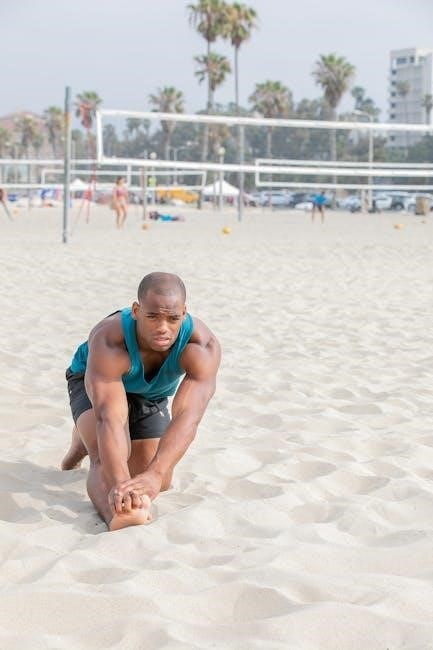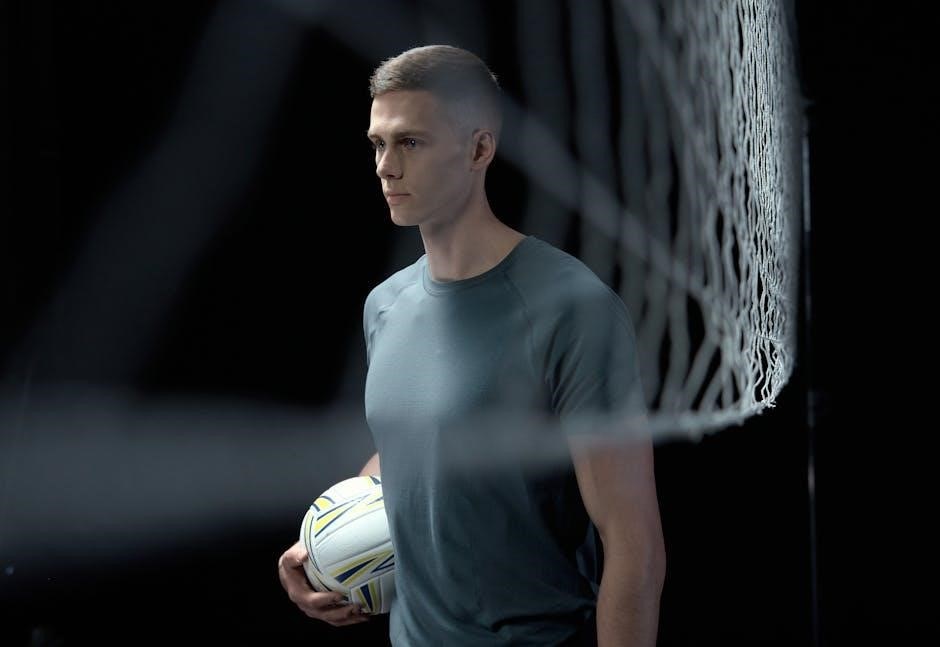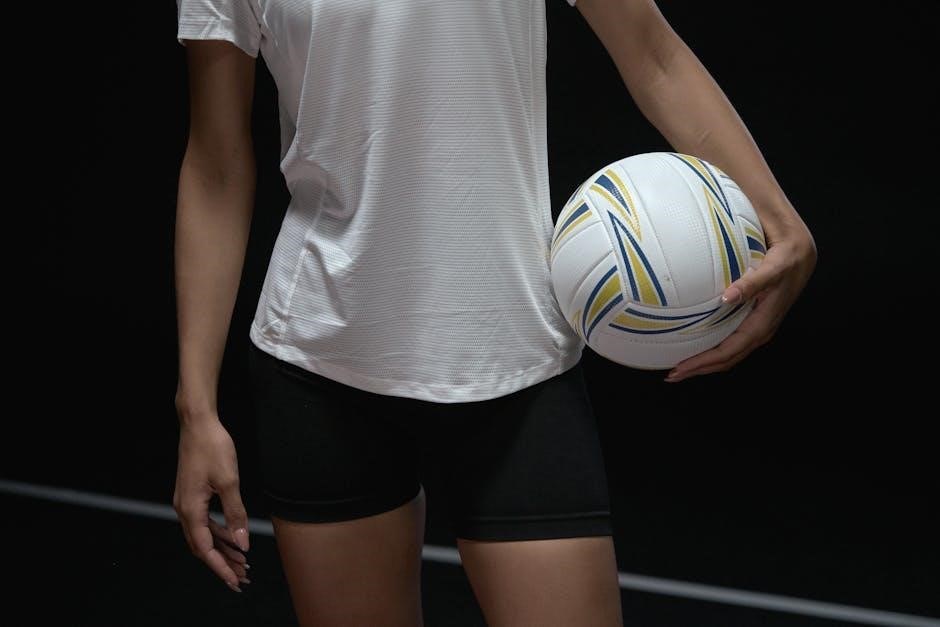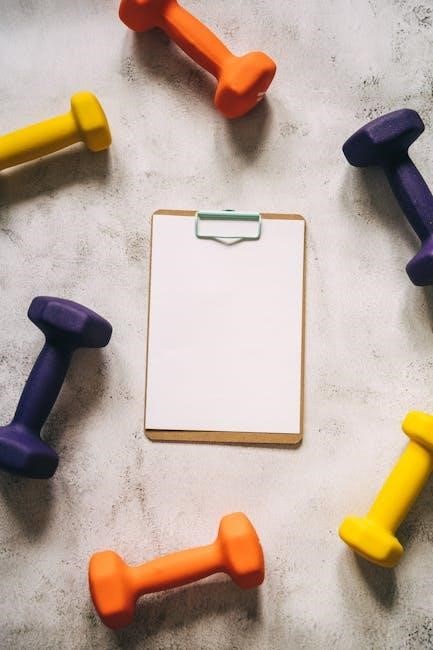A well-structured volleyball workout plan enhances performance, reduces injury risk, and improves overall athleticism․ It includes strength training phases, agility drills, and conditioning exercises tailored for volleyball athletes․
1․1 Importance of a Structured Workout Plan
A structured volleyball workout plan is essential for improving performance, preventing injuries, and ensuring balanced development․ It provides a clear roadmap, optimizing time and effort while addressing specific skills and physical attributes․ A well-designed plan helps athletes progress systematically, avoiding overtraining and plateaus․ It also ensures consistency, making it easier to track improvements and adjust strategies as needed for long-term success․
1․2 Benefits of Following a Volleyball Workout Plan
Following a structured volleyball workout plan enhances performance by improving strength, agility, and endurance․ It helps prevent injuries through balanced development and proper progression․ The plan ensures skill enhancement, physical conditioning, and mental focus․ Consistency in training leads to measurable progress, boosting confidence and overall athleticism․ A well-designed plan also supports long-term success by addressing specific needs and adapting to individual or team goals․
Warm-Up and Mobility Exercises
A proper warm-up and mobility routine prepare the body for intense training, preventing injuries and improving flexibility․ Essential for volleyball, it enhances movement efficiency and performance․
2․1 Dynamic Stretching Routine
Dynamic stretching is a crucial warm-up component for volleyball players, enhancing flexibility and range of motion․ It involves active movements like high knees, butt kicks, and arm circles․ These exercises prepare the muscles for explosive movements, improving power and agility․ Incorporating dynamic stretches 3 times a week, with 3 sets of 10-15 reps each, ensures optimal preparation for training and competition, reducing injury risk․
2․2 Mobility Drills for Volleyball Players
Mobility drills are essential for volleyball players to maintain flexibility and joint health․ Exercises like leg swings, hip circles, and torso twists improve movement efficiency․ These drills should be performed after dynamic stretching, focusing on controlled, full-range movements․ Incorporating mobility work 2-3 times weekly enhances court performance and reduces injury risk, ensuring players maintain peak physical condition throughout the season․

Strength Training for Volleyball
Strength training is crucial for volleyball players to build power and endurance․ It includes hypertrophy, eccentric, and strength/speed phases, ensuring progressive muscle development and performance enhancement․ Proper nutrition supports muscle growth․
3․1 Hypertrophy Phase (Weeks 1-2)
The hypertrophy phase focuses on building muscle mass through higher repetitions and lower weights․ Bodyweight exercises like squats, push-ups, and lunges are emphasized․ Athletes perform 3-4 sets of 12-15 reps per exercise, targeting major muscle groups․ This phase improves overall strength and endurance, preparing players for more intense training․ Proper nutrition and recovery are crucial to maximize muscle growth during this period․ Consistency ensures a solid foundation for future strength development․
3․2 Eccentric Phase (Weeks 3-4)
The eccentric phase targets muscle lengthening, enhancing strength and power․ Movements like slow squats, controlled push-ups, and resisted lunges are prioritized․ This phase improves joint stability and explosive movements, crucial for volleyball․ Athletes perform 4-5 sets of 8-10 reps, focusing on slow tempos․ This phase builds strength for jumping and quick changes of direction, essential for competitive play, while reducing injury risk through strengthened connective tissues․ Consistency is key․
3․3 Strength/Speed Phase (Weeks 5-6)
The strength/speed phase (weeks 5-6) focuses on explosive power and agility․ Athletes perform plyometric exercises like jump squats and box jumps, along with resisted sprints․ This phase enhances quick movements and reaction times, essential for volleyball․ Dynamic drills and functional movements are emphasized to build speed and coordination․ The combination of strength and speed training prepares players for competitive play by improving overall power and efficiency on the court․

Agility and Speed Training
This phase focuses on improving quickness, reaction time, and explosive movements․ Key exercises include jump rope drills and fast feet exercises to enhance volleyball-specific agility and speed․
4․1 Jump Rope Drills
Jump rope drills are essential for agility and speed․ Start with normal pace jumps for 60 seconds, then switch to fast-paced intervals of 30 seconds․ This improves foot speed and coordination, crucial for volleyball movements․ Incorporate variations like high knees and side-to-side jumps to enhance agility․ Perform 3-4 sets, increasing intensity gradually․ This drill boosts cardiovascular fitness and reaction time, vital for volleyball performance․
4․2 Fast Feet Exercises
Fast feet exercises enhance agility and quickness, essential for volleyball․ Perform 3 bursts of 10 seconds each, focusing on rapid foot movements․ These drills improve acceleration, deceleration, and directional changes, crucial for court movements․ Incorporate lateral shuffles and carioca drills to boost agility․ Consistency in these exercises enhances reaction time and overall performance, making players more effective during matches․
Conditioning and Endurance
Conditioning and endurance are vital for volleyball players to maintain stamina throughout matches; Circuit-based workouts and HIIT sessions, lasting 45 minutes, 3-4 times weekly, are recommended․
5․1 Circuit-Based Conditioning Workouts
Circuit-based conditioning workouts are effective for improving endurance and strength․ Perform exercises like bodyweight squats, push-ups, and lunges in 3 rounds of 10-20 reps; These circuits enhance cardiovascular fitness and muscular endurance, essential for prolonged volleyball matches․ They also promote functional strength, helping players maintain energy levels throughout the game․ Incorporate these circuits twice weekly for optimal results․
5․2 High-Intensity Interval Training (HIIT)

HIIT involves short bursts of intense activity followed by brief rest periods, improving speed, agility, and cardiovascular endurance․ Volleyball players benefit from drills like jump rope sprints, fast feet exercises, and explosive jumps․ Typically, HIIT sessions last 20-30 minutes, with 30 seconds of intense work followed by 30 seconds of rest, repeated for 8-10 sets․ This method enhances stamina and reaction time, crucial for competitive play․

Skill-Specific Drills
This section focuses on improving volleyball techniques like blocking, passing, and setting through targeted drills․ It enhances precision, timing, and coordination, essential for competitive performance․
6․1 Blocking and Approaching Drills
Blocking and approaching drills are crucial for defensive success․ Athletes practice explosive jumps, precise footwork, and timing to effectively block attacks․ These exercises simulate game scenarios, improving reaction speed and coordination․ Drills include repeated approach jumps, lateral movements, and partner-assisted blocking exercises to build strength and agility․ Consistent practice enhances defensive skills, ensuring players are prepared for competitive play․ These drills are essential for volleyball success․
6․2 Passing and Setting Exercises
Passing and setting exercises focus on improving ball control and precision․ Players perform forearm passes, overhead sets, and partner drills to enhance technique․ These exercises emphasize proper footwork, body positioning, and hand placement․ Consistent practice builds consistency and confidence, allowing seamless execution during matches․ Drills are tailored to simulate game situations, ensuring players are prepared for competitive play and can perform under pressure effectively․

Core and Functional Training
Core and functional training strengthens the abdominals, improves balance, and enhances overall stability․ Bodyweight exercises and dynamic movements mimic volleyball actions, boosting on-court performance․
7․1 Bodyweight Core Exercises
Bodyweight core exercises are essential for volleyball players, targeting the abdominals, obliques, and lower back․ Planks, Russian twists, and bicycle crunches improve stability and rotational power․ Alternating forward lunges and bodyweight squats also engage the core while enhancing overall strength․ These exercises can be performed anywhere, making them ideal for off-court training․ Proper form and progression are key to maximizing benefits and preventing injury․
7․2 Functional Movements for Volleyball
Functional movements are designed to mimic volleyball-specific actions, enhancing power, agility, and coordination․ Exercises like explosive jumps, lateral shuffles, and rotational movements improve game performance․ These drills simulate spiking, blocking, and digging, preparing athletes for dynamic plays․ By incorporating functional movements, players develop the ability to transition quickly and efficiently on the court, improving overall gameplay and reducing injury risk․
Periodization of the Workout Plan
Periodization organizes training phases to optimize performance, alternating between hypertrophy, eccentric, and strength/speed phases over weeks․ This structured approach ensures progressive overload and adapts to player needs․
8․1 Weekly Schedule and Progression
A structured weekly schedule balances strength, agility, and conditioning․ Monday focuses on agility, core, and lifting, while Tuesday and Thursday include blocking drills, approaches, sets, and passes․ Conditioning is integrated throughout the week, with dynamic warm-ups and mobility exercises essential for injury prevention․ Workouts are designed to be 45-60 minutes, ensuring progressive overload and adaptation․ Consistency and proper progression are key for optimal results․
8․2 Adjusting the Plan Based on Player Needs
The workout plan should be tailored to individual player needs, considering position, fitness level, and goals․ For example, libero players may focus more on agility and quick movements, while middle blockers prioritize strength and jumping ability․ Coaches can modify exercises, reps, and intensity to ensure progression and prevent plateaus․ Proper nutrition and recovery strategies are also adjusted to support each player’s performance and overall development․

Nutrition and Recovery
Proper nutrition and recovery strategies are crucial for volleyball athletes to optimize performance and muscle repair․ Balanced meals, hydration, and rest support energy levels and overall health․
9․1 Fueling for Performance
Proper nutrition is essential for volleyball athletes, ensuring they have the energy needed for intense training and matches․ A balanced diet rich in proteins, complex carbohydrates, and healthy fats supports muscle repair and sustained energy․ Hydration is also key, as even mild dehydration can impair performance․ Athletes should consume meals high in nutrients 1-3 hours before training or competition․
9․2 Recovery Techniques for Volleyball Athletes
Recovery is crucial for volleyball athletes to maintain performance and prevent injuries․ Techniques include dynamic stretching, foam rolling, and ice baths to reduce muscle soreness․ Adequate sleep and proper nutrition also play vital roles in recovery․ Additionally, active recovery methods like light cardio or yoga can improve flexibility and circulation․ Consistent recovery practices ensure athletes remain prepared for intense training and competition․
A structured volleyball workout plan enhances performance, reduces injury risk, and boosts overall athleticism․ Consistent adherence ensures long-term success and peak conditioning for athletes․
10․1 Final Tips for Success
Consistency is key to achieving volleyball workout goals․ Prioritize dynamic stretching and balanced nutrition for optimal performance․ Incorporate recovery techniques like foam rolling and hydration․ Stay motivated by setting achievable milestones․ Engage in cross-training to enhance overall athleticism․ Seek feedback from coaches to refine skills․ Remember, dedication and patience are essential for long-term success in volleyball․
10․2 Long-Term Benefits of the Workout Plan

Adhering to the volleyball workout plan enhances strength, agility, and endurance․ It improves overall performance and reduces injury risks․ Over time, players develop better coordination and game-specific skills․ The structured approach fosters discipline and consistency, leading to long-term athletic success․ Additionally, it promotes mental toughness and resilience, essential for peak performance in competitive volleyball․ These benefits contribute to a fulfilling and successful volleyball career․
